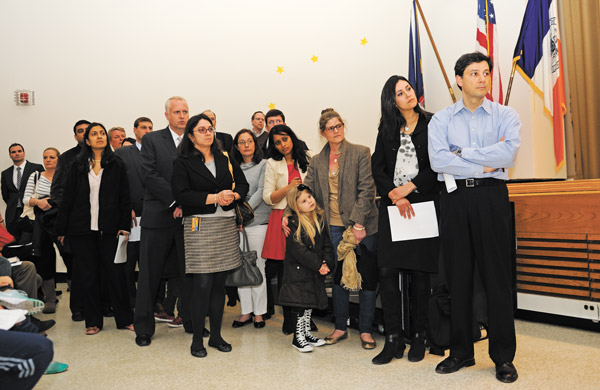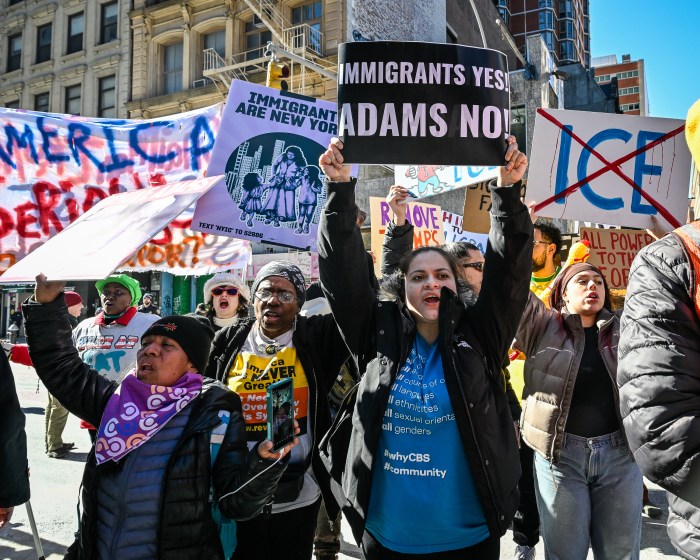
Some parents on the waitlist for Lower Manhattan schools spoke at least week’s Community Board 1 meeting.
By KAITLYN MEADE and JOSH ROGERS | When the school waitlists were tallied in April, 148 kids were left without a seat Downtown — and now parents and community leaders are searching for an alternative to the Department of Education’s knee-jerk reaction to send students to seats outside their neighborhood.
At Community Board 1’s full board meeting on April 23, about a dozen families gathered to testify on the waitlist issue and to ask for support from the board.
“I felt that there was support from the board,” said Ariana Massouh, who started a change.org petition demanding the Dept. of Education find space closer to home that has now garnered almost 500 signatures. Her daughter is last on the waitlist for 276.
She said that parents were initially told by the D.O.E. that their kids would most likely be offered seats in Chinatown or the Village — too far away for most of them. “It’s obviously very disconcerting. We’re not comfortable with the supposed plan to bus them to other schools,” said Massouh.
A similar solution has been proposed in years past, but was strongly opposed by parents and community leaders.
“The D.O.E. is aware of our position that they need to find seats Downtown,” said C.B. 1 Youth and Education Chair Tricia Joyce. “We’ve exhausted all of our band aids. We have no more space.”
She said she had called principals in surrounding neighborhoods and determined that those schools were not a good fit to solve the waitlist problem, even if they offered a handful of seats.
At a School Overcrowding Task Force meeting with Chancellor Dennis Walcott April 4, the chancellor said he wanted to look at the smaller neighborhood “pockets” with large population growth. D.O.E. officials seemed to back off a bit at a follow-up meeting April 29, but advocates are still hopeful a new Lower Manhattan school will be included in the capital plan due Nov. 1.
Prior to Monday’s meeting, Joyce said there’s a pressing need now for this year’s waiting list.
“They’ve converted space over the summer before, several times, and they need to do it now,” she said.
One option discussed in the past was to incubate extra kindergarten sections for the Peck Slip School at the Tweed Courthouse, which is designed to open only two sections per grade, per year.
Eric Greenleaf, a Downtowner who has closely tracked the school population numbers, said Tweed should definitely be considered as a partial solution.
“Can it be expanded by one room? Yes,” he said. “Two rooms? Probably. More than that? I don’t know, but that’s something that’s really up to the principal.”
He said there’s room on the first floor to add a classroom, but one complication about adding too much more space to the D.O.E. headquarters is having adequate bathroom and outdoor play space for the additional students.
Joyce also cautioned that any action should be taken only in cooperation with Peck Slip’s principal Maggie Sienna.
“They shouldn’t do it unless they have her oversee it,” she said.
Sienna is already taking in a section of Pre-K this year in a “one-shot deal” to alleviate crowding at P.S. 276.
Massouh said she had heard that there were many options on the table, including building annexes or finding temporary space, but that parents were told not to expect anything until June, when the D.O.E. usually sends out its alternate offers, “which leaves us very little time to pick up and move, which some of us will be doing if there is no resolution.”
At a P.S. 89 meeting on Wednesday evening, parents were advised to accept the offers the D.O.E. sent out on June 12, said Crystalyn Stuart. She found 89’s team to be very transparent and helpful, despite the fact that her daughter was originally number 44 of 44 on the P.S. 89 waitlist. At the meeting she learned that 11 offers had been made to students 89’s waitlist and that 4 had withdrawn their slots, “so the list is moving.”
However, even with a moving waitlist, there may be too many kids to farm out to area schools. “The D.O.E. is saying, ‘We’ll find you a place somewhere,’ but that’s not the point. The point is that they’re entitled to a place in their zoned school,” said Greenleaf. “If they absolutely refuse to build schools, people are unquestionably going to move out.”




































